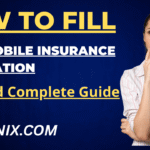How to Fill out an Automobile Insurance Application: Easy and Complete Guide
Applying for an automobile insurance can be daunting, especially if it’s your first time or you’re changing providers. Don’t worry, the process becomes simpler when you know what is expected of you and how to provide relevant details. This guide will provide you with a step by step walkthrough on how to fill out an automobile insurance application so that you have the best preparation for the most relevant coverage and cost.
This article is beneficial whether you are submitting the application physically or online. With the information provided through this article, you will be able to minimize errors, streamline the process, and improve your chances of obtaining a better offer.
Table of Contents
Why Is It Important to Fill Out the Insurance Application Correctly?
Documents You’ll Need Before Starting
Step-by-Step Guide to Completing an Application for Auto Insurance
Step 1: Personal Information
Step 2: Vehicle Information
Step 3: Driver Information
Step 4: Insurance History
Step 5: Selection of Coverage
Step 6: Discounts and Additional Information
Step 7: Submission Review
Common Errors to Avoid
What is the Next Step After Submitting the Application?
Commonly Asked Questions
1. Why Is It Important to Fill Out the Insurance Application Correctly?
The application for automobile insurance is a crucial document for both insurers and policyholders. An insurance company uses the information in your application to compute your premium and evaluate your exposure. Even minor mistakes or missing information can result in:
Increased premiums
Cancellation of the policy
Denial of benefits
Possible legal repercussions in the event of an accident
Accurate information assists in reducing problems during the life of the policy and financial liability in the future.
2. Documents Required Before You Start
Before beginning the application form, make sure to collect the following documents in order to streamline the process.
Driving license (for all licensed drivers on the policy).
Title or registration of the vehicle.
Current mileage and VIN (Vehicle Identification Number) of the vehicle.
Previous insurance documents.
Bank account information (in case of receiving payment through direct deposit).
Driving history including any accidents or crimes.
If you have these items in hand, your application process will be faster and smoother.
3. Comprehensive Instruction Guide for Completing an Auto Insurance Application
Step 1: Provide Personal Information
The first section requires you to enter some basic personal details including;
Your full legal name
Date of birth
SSN (Social Security Number) in certain cases
Physical address (not P.O. Box)
Telephone number and email address
Current marital status
Job title and name of employer.
All this information helps assess the insurance risk and eligibility for various applicable discounts.
Step 2: Vehicle Information
You will provide the following details regarding the car and its usage:
Year, make, and model.
Vehicle Identification Number (VIN).
Mileage and its usage (commute, personal, business etc).
Ownership status (i.e. owned, leased, financed).
Garaging address (where the car is parked overnight).
This information is used by insurers to assess the value and replacement costs of the vehicle and the risk for theft.
Step 3: Identify All Drivers
Every driver in your household must be identified irrespective of how often they use the insured vehicle. In this section, outline:
Their name and relationship to you
Driver’s license number and state of origin
Years of driving experience
Record of traffic infractions or collisions
Tip: Certain insurance companies permit you to exclude specific drivers from your policy. However, this exclusion must be documented and detailed.
Step 4: Give Insurance History
Your previous insurance policies will have an impact on your rates, so be prepared to answer the following questions:
Who was your last insurer?
When did your policy start and end?
What was the reason for switching or cancellation?
Were there any gaps in coverage?
In the absence of prior insurance, expect to pay more, especially if you are a young driver. Honesty is critical here — insurers can crosscheck your claims.
Step 5: Select Your Coverage Selections
This section focuses on the application’s main activity. You need to select coverage options from the following list:
Liability insurance (bodily injury & property damage) – required by most states
Collision coverage – damages to your vehicle from accidents are covered
Comprehensive coverage – non-collision damages are covered (theft, fire, weather)
Uninsured/underinsured motorist – you are protected if the at-fault driver has no coverage or low coverage
Medical payments/PIP – assists with the payment of medical expenses
You will also need to choose the limits and deductibles for each type of coverage. Policies with high deductibles tend to have lower premiums, but the insured will have to spend more out-of-pocket for expenses when filing a claim.
Section 6: Integrate Discounts and Additional Features
Make sure to take full advantage of available discounts, which differ by company and may include:
Multi-car and multi-policy bundles
Good student programs
Safe driver incentives
Telematics or usage-based programs
Low-mileage
Completion of a defensive driving course
Insurers may also offer optional enhancements such as:
Roadside assistance
Rental reimbursement coverage
Gap insurance (especially useful when there is negative equity on a financed vehicle).
Section 7: Check and Submit
If you plan to submit online, make certain you do not leave any fields blank. After pressing submit, check the following items:
Name spellings
Driver License and Vehicle Identification Number (VIN)
Start date for the policy
Selected coverage amounts
Discounts confirmed and applied
When everything is accurate, proceed with submission. Applications are generally processed instantly for online submissions or manually reviewed within 24-48 hours after the receipt for all other submission forms.
Repeated Errors
To circumvent time wastage and address all potential concerns, ensure the following errors are avoided:
Using an incorrect vehicle identification number
Not including all named drivers
Misrepresenting mileage or vehicle usage
Failing to properly disclose previous accidents or violations
Selecting coverage limits without fully understanding said limits
Not including applicable discounts
Failing to review before the final submission, precision is essential.
What Happens After You Submit the Application?
This will be like:
a. Offer of Quote and Policy
You will get a quote that will be based on the details you provided. If you accept it, payment will be made and thus coverage will be activated.
b. Underwriting Review
Certain companies will validate your information, for instance, by checking your credit reports, DMV records, and previous insurance claims.
c. Policy Documents
As soon as approval has been granted, you will get your insurance ID cards, policy declaration page, and terms & conditions with the email or mail option.
d. Effective Coverage
The majority of policies give you the option to activate immediately or on a date you choose in the future. First ensure that you cancel your previous policy only after the new one is active.
FAQs – How to Fill Out an Auto Insurance Application
Q1: Is applying for car insurance online available?
Yes. The majority of insurance firms have enabled swift and safe application procedures online with a duration of completion between ten and twenty minutes.
Q2: Am I required to list all members of the household under my insurance?
Yes. All individuals residing in one’s household with access to the vehicle should be listed as part of the insurance, even if they do not regularly drive it.
Q3: What should I do if I make an error on the application?
It is best to call the insurance agency and correct any minor mistakes immediately. Greater inaccuracies may result in cancellation of policy or claims denial.
Q4: Does coverage lapse affect my insurance profile?
Indeed. Discontinuation of auto insurance may incur higher premiums or complete denial of coverage. Maintaining continuous coverage is preferable at all times.
Q5: Never had insurance can that to a person’s profile?
No, but insurers perceive it as a more significant risk which is especially true for younger or new drivers. Increased costs initially are compensated by discounts over time.
Q6: Is there an obligation to pay right away after applying?
In most cases, the answer is affirmative. It is required to pay the first month’s premium or the entire amount if choosing to pay upfront.
Q7: How can I determine how much coverage I need?
A combination of state laws, the value of the vehicle and one’s financial situation dictates the answer. Seeking assistance from a licensed agent may prove beneficial.
Concluding Remarks
Completing an automobile insurance application should not be a source of stress. With the right approach and organization, the entire process can be completed efficiently and decisively. It is important to offer precise details, be clear regarding the terms of protection desired, and pose any necessary inquiries prior to submission.
Adhering to this guide will enable you to obtain car insurance coverage that is dependable and safeguards both you and your automobile, ensuring peace of mind while driving.




1 thought on “How to Fill out an Automobile Insurance Application: Easy and Complete Guide”